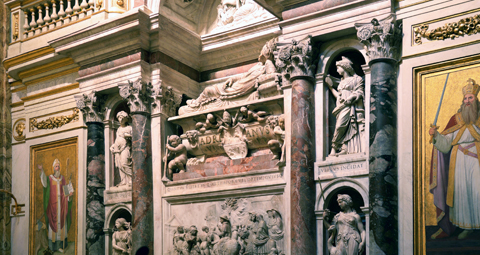April 20 | ![]() 0 COMMENTS
0 COMMENTS ![]() print
print

The Pope who tried to reform the Church
A trip to Rome has THE BOW IN THE HEAVENS reflecting on fearsome pontiffs and sacred art — By FR JOHN BOLLAN
Just as I filed last week’s column from the departure lounge at Glasgow airport, so I’m dispatching this week’s from Leonardo Da Vinci airport on the outskirts of Rome. As I predicted, or I should say as the meteorologists predicted, the weather was pretty mixed: certainly not the hot weather I have become accustomed to during my Easter vacation. Still, it’s always lovely to be in Rome, even when it’s wet.
Pope Francis clearly had been tipped off about my arrival last Monday, as he chose that day to publish his new Apostolic Exhortation on Holiness. To be honest, I haven’t read it yet, beyond a few highlights which ended up in my email inbox. A more thorough perusal is, of course, on the ‘to-do’ list for when I get back home. If I’m being even more candid, I didn’t even go near the Vatican this time, not even to meet up with my parishioners.
We did get together after the angelus, however, and enjoyed a pleasant lunch before I shepherded them to Finnegan’s, where they could enjoy livecoverage of a sporting event back in Glasgow. They were due to attend the Rome derby between Lazio and Roma that evening, and I must say I was very envious of the opportunity to see an on-form Roma in the flesh.
Midweek, I had to make do with watching the Champions’ League Rome v Barcelona fixture in a bar near the Pantheon. That same afternoon, I had treated myself to a new Roma top, my first in more than 10 years, and a very fetching rucksack (below) in the team’s giallorosso (yellow and red) colours.
It was an incredible game and I attribute Rome’s glorious victory over Carthage (well, Barcelona was a Carthaginian settlement) to my carrying the she-wolf on my chest and the rucksack around my shoulders. Indeed, I now call it ‘the lucksack’ and it is available for hire during crucial matches. St Mirren may not require it this year, but I’m waiting for a phone call from Cappielow.
As a Classicist, one of the pleasures of returning to the Eternal City is the discovery of new places to visit or old places of interest which have been repackaged, often with the latest technology, for a new generation of visitors.
As well as some old favourites, such as the excavations beneath San Clemente, this year I descended to the level of the original stadium of Domitian in the Piazza Navona, the Roman houses beneath the Palazzo Valentini (in the shadow of Trajan’s column) and, my particular favourite, a multimedia reconstruction of the Ara Pacis (the altar of Augustan Peace).
Not that I completely disdain Christian Rome, of course: just because I avoided the crowds at the Vatican doesn’t mean that I failed to show due respect to a variety of deceased pontiffs in their resting places dotted around the city. I always say a prayer before the tomb of Leo XIII, the first pope to elaborate what we now call Catholic social teaching, in the cathedral of St John Lateran.
I try to keep on good terms with St Pius V in St Mary Major’s and even better terms with Julius II, ‘Il papa terribile’ (or ‘fearsome pope’) who was Michelangelo’s great patron and sparring partner.
Michelangelo built him a handsome tomb in St Peter in Chains, although I believe it was not quite on the scale that the pope had originally commissioned.
Even as it stands, it is a pretty extravagant statement of papal power and temporal glory: the sculpted figure of Julius lies there, alert and erect, the triple tiara of the Roman pontiff merely serving to accentuate the hard stare he’s giving anyone with the temerity to look him in the eye. Here is a pope who gazes at the world and says, ‘come ahead!’
How different, by contrast, is my favorite papal tomb, that of Adrian (or Hadrian) VI in Santa Maria dell’Anima, near the Piazza Navona. He was the last non-Italian pope before John Paul II, a Dutchman who valiantly attempted to reform the Church from within before Luther’s revolt caught hold and ripped the Church apart.
Sadly, his best efforts were hampered by a lack of cooperation from his closest collaborators. He died in 1523, worn out and frustrated.
His funerary monument shows us a very different kind of pope. Adrian appears more slumped in resignation than recumbent in repose; his eyes are closed and his hand is supporting the massive weight of the papal tiara. He looks thoroughly scunnered, poor chap. Under the effigy of the pontiff is one of the trickiest lines of Latin in Rome (harder even than the inscription on the diving step of the Scots College swimming pool which has baffled more distinguished Latinists than I).
Adrian’s inscription, obviously written about him rather than by him, is pretty untranslatable, but the sentiment is a poignant one, I think. A very loose rendering, but the best I can come up with, is: “It doesn’t matter how good you are, if the times you live in are bad.’
That certainly summed up Adrian’s times and, some would say, ours too. It can be very hard trying to be good, especially when the world around you doesn’t recognise or understand your kind of goodness.
What compounded the tragedy of Pope Adrian was that much of his opposition arose from within the Church: vested interests that had to be protected, priestly politics trumping the Gospel, a kind of careerism which saw the Church as a means of advancement rather than of service. It would be nice to think such things are less prevalent nowadays.
My own attachment to Pope Adrian stems from my own student days in Rome. I had a close-up of his slightly pained expression pinned to the door of my room, so that any visitor saw him before they saw me. I’m not sure why I formed this bond with a fairly obscure pope: I’m sure it was born, in part, from a profound sympathy for someone who tried his best but, in the last analysis, found that his best wasn’t quite enough to carry the day. Even popes have to accept that you can’t win them all.
Speaking of the relationship between the Church and artists, especially sculptors, I recently had a little parish mystery solved for me. A few weeks ago, I mentioned that I had installed a sculpted relief of the Lamb of God in the cry chapel but had no knowledge of its provenance, other than it having sat in a confessional for goodness knows how long. I surmised it had been salvaged from another church, now closed: the truth is even more interesting.
I received a visit from a lady who thought she recognised the relief from a portfolio of her late husband’s work as a student at the Glasgow School of Art. She produced a folder full of black and white photographs of a number of sculptures, in a variety of classical, religious and modern styles. I found them stunning but was a little horrified to learn that they had all been destroyed at the conclusion of his degree in 1952. All, but one, I should say.
He had approached my predecessor, Canon Barclay, to offer him the Agnus Dei for St Joseph’s (which was not long built at that time).
The good canon accepted the offer, but I do not know if it was ever displayed. It would be a shame if it had simply languished in a confessional ever since, but at least it was spared the ignominy of the scrap heap. The sculptor, Alberto Caniffi, went on to have a successful career as an art teacher, both in Greenock and in Paisley. I hope he and his family are pleased that it can now be seen by the parishioners to whom it was given nearly 70 years ago.
We may not have busloads of tourists piling out into the Piazza San Giuseppe, but I reckon we have our own unique works of art which embellish our little church and give glory to God in the process. In my own characteristically modest way, I’d like to think I’m continuing the tradition of those great Roman patrons of the arts who left their collections and their names behind them in their imposing palaces dotted around the city, to say nothing of the popes themselves.
Having said that, I’d rather be an Adrian than a Julius: if for no other reason than that folk might just think ‘il parocco terribile’ simply meant ‘the terrible parish priest.’ And that’s a reputation no one wants.










